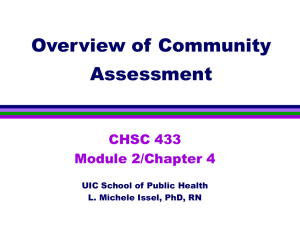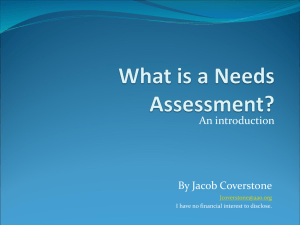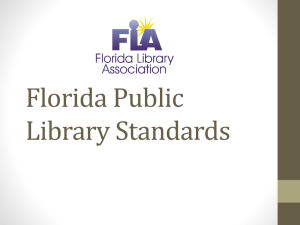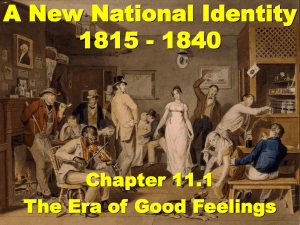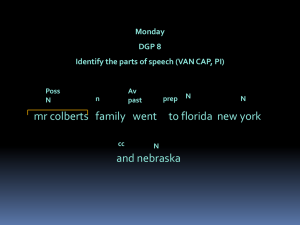Needs Assessment
advertisement
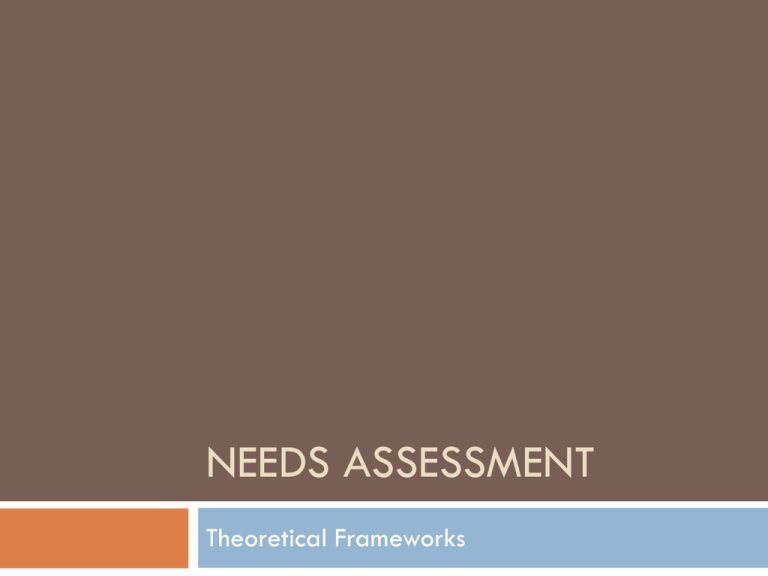
NEEDS ASSESSMENT Theoretical Frameworks Defining or Considering Needs Need is relative, but norms are established “A condition that limits a person from meeting his potential” (Social Security Act, 1974) Theoretical Understanding of Need Ponsioen (1962) - society’s first responsibility is to meet basic survival needs of its members, biological, social, emotional and spiritual Ponsioen asserts that every society will identify a level below which no one should fall Theoretical Understanding of Need Maslow (1954) Hierarchy of Needs – lower needs must be satisfied before higher can be addressed Why Conduct a Needs Assessment? To guide decision-making To provide justification for decisions before they are made To provide a systemic perspective for decision-makers To allow for interdisciplinary solutions for complex problems To offer a replicable process that can be used over and over again To focus partners (or the network) on shared understanding of issues and shared goals What is a Needs Assessment? A systematic process of asking questions, comparing answers, and making informed decisions about what to do next to improve human (or organizational) conditions and performance Assessing Needs Types of need Normative Perceived Expressed Relative • Primary challenges: Reliability and availability of data Perspectives on Need Normative need Existence of standards or criterion established by custom, authority or general consensus against which quantity or quality of a situation or condition is measured Work with existing data Generates objective targets Need levels change as knowledge, technology and values change Perspectives on Need Perceived need Need defined by what people think or feel about their needs Allows for responsive service delivery Interviews, focus groups, town meetings Standard changes with each respondent Perspectives on Need Expressed need Need defined by the number of people who have actually sought help Focuses on circumstances in which feeling is translated to action Major weakness is the assumption that all persons with need seek appropriate help Perspectives on Need Relative need Gap between level of services existing in one community and those existing in similar communities or geographic areas Must consider differences in population and social pathology Concerned with equity Needs Assessment and Program Planning Problems are translated to needs, needs are translated to interventions Needs assessment starts with problem analysis Integrates qualitative and quantitative methods Informs solutions and can define the size of the target group Needs are translated into measurable objectives, resources, and criteria necessary for program planning and evaluation Needs Assessment Methodologies Extrapolating from existing studies (normative need) Using resource inventories (normative and relative need) Using service statistics (expressed and relative need) Conducting social surveys (perceived need) Holding a public forum (perceived need) Arts & Health Needs Assessment What are the five most significant health concerns in your community? What are the most significant arts or cultural needs of the people you serve? What other concerns are significant in your community? What is needed to address those concerns? What is unique about your community? What are its strengths? What services or programs don’t exist that should? Is there anything that you would like us to know about your community? Approaches to Locating Un/Underserved Social problems and needs are not distributed equally in geographic space; for example, county statistics may not reflect the needs in some unserved pockets within the county Spatial analysis – use of social or health indicators to classify geographical areas into typologies Factor analysis – statistical technique that can take large numbers of variables and reduce to a smaller number of constructs or indicators An example might include aggregating social indicators such as: occupation, education, income, fertility rate, women who work, single family dwelling units, and % in Ethnic Groups References Bradshaw, J. (1972). The concept of need. New Society, 30, 640-643. Kettner, P.M., Moroney, R.M., Martin, L.L. (2008). Designing and managing programs: An effectiveness-based approach. Los Angeles, Sage. Maslow, A. (1954). Motivation and personality. New York: Harper & Row. Ponsioen, J. (1962). Social welfare policy: Contributions to theory. The Hague, the Netherlands: Mouton. Wallace, H., Gold, E., & Dooley, S. (1967). Availability and usefulness of selected health and socioeconomic data for community planning. American Journal of Public Health, 57, 762-771. http://www.needsassessment.org/ COMMUNITY NEEDS ASSESSMENT RESOURCES & RURAL HEALTH PRIORITIES FLORIDA OFFICE OF RURAL HEALTH February 2012 Bad News! Community needs assessments can require a lot of time and effort. Good News! Most of the counties in Florida have or are in the process of conducting a community needs assess. Florida’s county health departments are required to conduct periodic community needs assessments using the Mobilizing for Action through Planning & Partnership (MAPP) process. The IRS now requires non-profit hospitals to report community benefits based on a community wide assessment of needs. HEALTH COUNCILS Regional health planning agencies that work with local communities to identify needs. Not for profit, 501c3 organizations Boards are representative of the counties in their region Consumer, health provider, health insurers RESOURCES County Health Department Local Health Council Local Hospital Florida Department of Health CHARTS www.floridacharts.com/charts/chart.aspx FLORIDA’S RURAL HEALTH PRIORITIES Primary care services Specialty physician services Oral health services Behavioral health services
